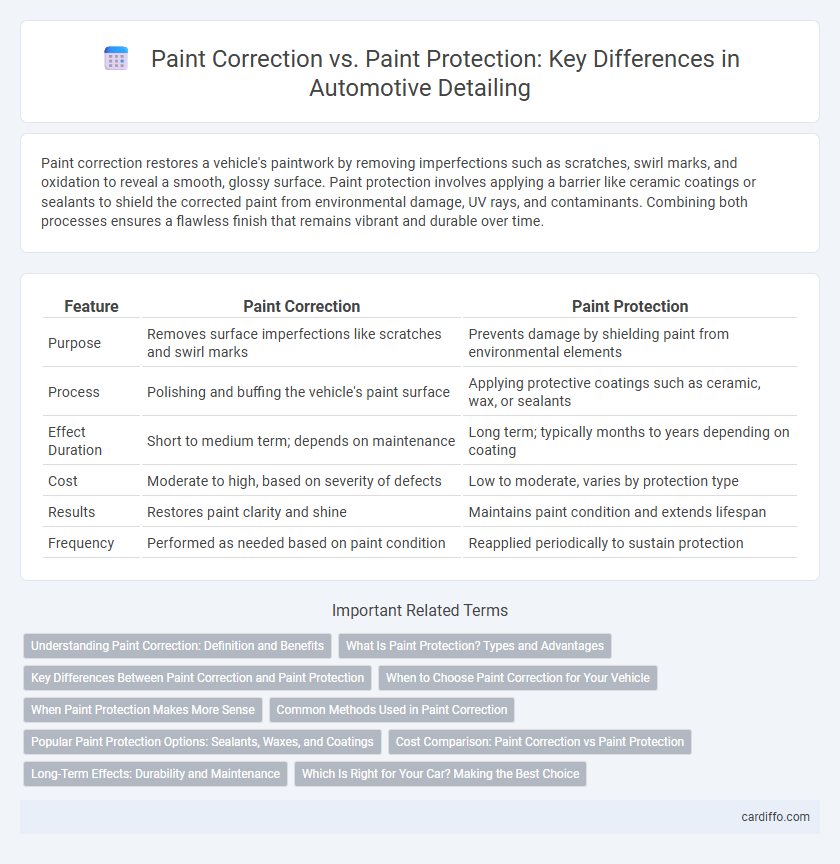Paint correction restores a vehicle's paintwork by removing imperfections such as scratches, swirl marks, and oxidation to reveal a smooth, glossy surface. Paint protection involves applying a barrier like ceramic coatings or sealants to shield the corrected paint from environmental damage, UV rays, and contaminants. Combining both processes ensures a flawless finish that remains vibrant and durable over time.
Table of Comparison
| Feature | Paint Correction | Paint Protection |
|---|---|---|
| Purpose | Removes surface imperfections like scratches and swirl marks | Prevents damage by shielding paint from environmental elements |
| Process | Polishing and buffing the vehicle's paint surface | Applying protective coatings such as ceramic, wax, or sealants |
| Effect Duration | Short to medium term; depends on maintenance | Long term; typically months to years depending on coating |
| Cost | Moderate to high, based on severity of defects | Low to moderate, varies by protection type |
| Results | Restores paint clarity and shine | Maintains paint condition and extends lifespan |
| Frequency | Performed as needed based on paint condition | Reapplied periodically to sustain protection |
Understanding Paint Correction: Definition and Benefits
Paint correction is a professional process that removes surface imperfections such as swirl marks, scratches, and oxidation from a vehicle's paint using abrasive polishing compounds and specialized tools. This technique restores the paint's clarity and depth, enhancing the car's overall appearance and increasing its resale value. Unlike paint protection, which aims to shield the surface from future damage, paint correction focuses on repairing and rejuvenating existing paintwork flaws.
What Is Paint Protection? Types and Advantages
Paint protection involves applying specialized coatings or films to a vehicle's surface to safeguard the paint from environmental damage, such as UV rays, chemical stains, and minor scratches. Common types include ceramic coatings, paint protection films (PPF), and sealants, each offering varying levels of durability, gloss, and resistance. Advantages of paint protection consist of prolonged paint lifespan, enhanced gloss and appearance, easier cleaning, and increased vehicle resale value.
Key Differences Between Paint Correction and Paint Protection
Paint correction involves the removal of surface imperfections such as swirl marks, scratches, and oxidation through polishing techniques, restoring the vehicle's original paint finish. Paint protection, on the other hand, refers to the application of protective coatings like ceramic, sealants, or waxes that create a barrier against environmental damage, UV rays, and contaminants. While paint correction addresses existing paint defects, paint protection aims to preserve the corrected surface and prevent future degradation.
When to Choose Paint Correction for Your Vehicle
Paint correction is ideal when your vehicle exhibits surface imperfections such as scratches, swirl marks, oxidation, or etching that compromise the paint's clarity and depth. This process uses abrasive compounds and polishing techniques to restore the original finish by removing a thin layer of the clear coat, effectively rejuvenating the paintwork. Choose paint correction before applying any paint protection products to ensure a smooth, defect-free surface that maximizes the durability and appearance of sealants or ceramic coatings.
When Paint Protection Makes More Sense
Paint protection makes more sense than paint correction when the vehicle's finish is relatively intact and free from severe scratches or oxidation, as protection preserves the current condition and prevents future damage. Ceramic coatings, paint protection films, and sealants offer long-lasting barriers against UV rays, contaminants, and minor abrasions, reducing the need for frequent corrections. Investing in quality paint protection minimizes maintenance costs and retains the vehicle's showroom shine over time.
Common Methods Used in Paint Correction
Common methods used in paint correction include machine polishing, compound polishing, and wet sanding, each targeting different levels of surface imperfections such as swirl marks, scratches, and oxidation. Machine polishing utilizes rotary or dual-action polishers combined with various abrasive pads and compounds to restore paint clarity and smoothness effectively. Wet sanding involves a more abrasive approach using fine-grit sandpaper with lubrication to eliminate deeper defects before polishing to achieve a flawless finish.
Popular Paint Protection Options: Sealants, Waxes, and Coatings
Popular paint protection options include sealants, waxes, and ceramic coatings, each offering varying levels of durability and finish enhancement. Sealants provide long-lasting protection by bonding chemically with paint, while waxes offer a natural shine but require frequent reapplication. Ceramic coatings deliver superior resistance against contaminants and UV damage, making them a preferred choice for long-term paint preservation.
Cost Comparison: Paint Correction vs Paint Protection
Paint correction typically costs between $300 and $1,200 depending on the extent of swirl marks and imperfections, while paint protection options like ceramic coatings range from $500 to $2,000 based on product quality and application complexity. Paint correction is a one-time expense aimed at restoring paintwork, whereas paint protection involves an upfront investment with long-term benefits in preserving the vehicle's finish and reducing future maintenance costs. Choosing between paint correction and paint protection depends on budget priorities and desired durability, as correction addresses existing damage and protection prevents further wear.
Long-Term Effects: Durability and Maintenance
Paint correction restores a vehicle's surface by removing imperfections such as swirl marks and oxidation, enhancing the paint's clarity and shine. Paint protection methods, including ceramic coatings and paint protection films, create a durable barrier that shields the corrected paint from environmental contaminants, UV damage, and minor scratches. Combining both provides long-term durability, reducing maintenance frequency and preserving the vehicle's pristine appearance over time.
Which Is Right for Your Car? Making the Best Choice
Paint correction removes surface imperfections such as swirl marks, oxidation, and scratches, restoring your car's original shine and smoothness. Paint protection, including ceramic coatings and sealants, shields the corrected paint from future damage, UV rays, and contaminants, ensuring long-lasting durability. Choosing between paint correction and protection depends on your vehicle's current condition and maintenance goals, but optimal results often come from combining both treatments.
Paint correction vs Paint protection Infographic

 cardiffo.com
cardiffo.com